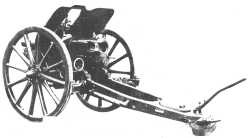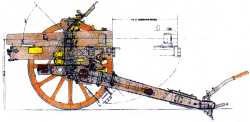|
| ||||||||||||||||||||||||||||
QF 4.5-in Howitzer | ||||||||||||||||||||||||||||
Following the lessons of the South African War (1899-1902)' an Ordnance Committee sat to select a howitzer to replace the BL 5-inch. Having agreed on a desired performance they invited the nations' armament makers to submit designs, then sat back to await results. In due course the Committee accepted a design for a QF 4.5-inch (114-min) howitzer submitted by the Coventry Ordnance Works (COW). The equipment was eventually introduced in 1909. The new piece featured a horizontal sliding block breech mechanism, the first used in a British gun except the QF 18-pr Mk 3 which did not advance beyond the experimental stage. |
| |||||||||||||||||||||||||||
|
It was much favoured in European armies and closely resembled one or two German howitzers of similar calibre. See Figs 1 and 2. | ||||||||||||||||||||||||||||
|
A Mk 2 gun produced in 1917 differed in having the corners of the breech ring radiused to prevent cracking. Also, the rifling was changed from an increasing twist to a uniform twist, as the change made no difference to the performance of the piece and made machining easier. The Mk 2 howitzer's range was 7,300 yards (6675 metres). From the outside the Mk 2 appeared identical to the Mk 1. By 1914 182 howitzers had been manufactured while during the war another 3177 were produced, of which 400 went to Russia. Prior to the war a number were sold to the colonies. |
| |||||||||||||||||||||||||||
|
A New Zealand battery supported ANZAC troops on Gallipoli - when it had any ammunition. Unfortunately, in that mismanaged campaign the howitzers available were far too few to provide adequate support for the Infantry nor did they ever have sufficient ammunition for that purpose. Officially the 4.5 howitzer became obsolete in 1944 but remained in service in New Zealand until 1957. Four were retained at the School of Artillery, Waiouru, when it commenced operation in 1948. The howitzers were still accurate, and as a fairly large amount of ammunition remained in store, they were kept principally for the training of officers in observation of fire, for which they proved ideal. Unfortunately, in 1957 occurred a fire in the camp which destroyed the School store and with it the howitzers' sight brackets. There being no spares available the equipments were therefore rendered useless. Fortunately they were not all sold for scrap; two may still be seen at the School while another (equipped for horse draught) may be seen at the Army Memorial Museum. | ||||||||||||||||||||||||||||
|
Fig. 3, from a photograph taken in 1938, shows a howitzer just before being mechanised in June of that year. The soldiers are members of 14 Wing, RNZA, undergoing training at the Army Schools of Instruction, Trentham. Mechanisation of the 4.5 carriage involved the fitting of the Martin Parry conversion kit similar to that provided for the 18-pr Mks 1 and 2 guns. |
| |||||||||||||||||||||||||||
|
The 4.5 howitzer was the last field branch howitzer to serve in the Commonwealth forces. During World War 1 the field artillery brigade (renamed 'regiment' in 1938) was a composite unit, consisting of three batteries of field guns plus one of 4.5-in howitzers, the latter with their high trajectories being called on to clear obstacles which the former with comparatively flat trajectories could not. With the greater mobility necessary in modern warfare plus the increasing cost of equipment it became highly desirable to adopt a 'gun-howitzer', i.e. a piece which could carry out the tasks of both high and flat trajectory equipments, and naturally fire a single type of ammunition. Thus both the QF 18-pr and the 4.5-in howitzer were superseded by the QF 25-pr. | ||||||||||||||||||||||||||||
|
GENERAL INFORMATION:
| ||||||||||||||||||||||||||||
|
WL Ruffell
Read about the QF 25-pounder | ||||||||||||||||||||||||||||


